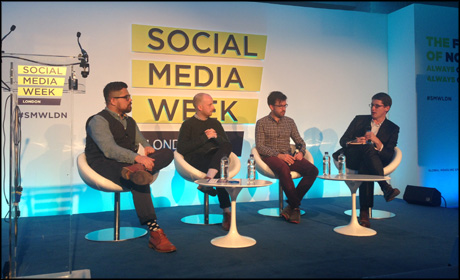
A decade ago, the most common way for journalists to get wind of a story was to experience or hear about something first-hand, or by receiving information via a wire service.
In modern newsrooms, social media and the prevalence of smartphones means news posted in real-time is now more accessible to media outlets than ever before.
However, this influx of information – together with audiences now conditioned to expect to read about breaking news as it happens – raises challenges as well as opportunities.
"There's more and more stuff out there, and so finding the signal in the noise is harder," said James Montgomery, director, digital and technology for BBC News and BBC World Service.
"And secondly, the life cycle is getting faster and faster so you find out about stuff quicker and you get it out on Twitter and Facebook."
As part of Social Media Week, Montgomery joined representatives from the Guardian and The Telegraph to explain how data and technology is shaping real-time reporting.
BBC News
Real-time news posted to social media presents an editorial challenge because, as Montgomery noted, the content is visible to everyone, meaning reporters can often end up covering the same stories.[Tools are] only the start of the process. You have to apply some journalism to verify it.James Montgomery, BBC News and World Service
In order to distinguish themselves, news outlets should think carefully about how they present stories, he added.
"We work very hard to get the story right and not just to repeat what we see and what we've been told, but to verify it, to contextualise and explain it."
Although Montgomery noted that there were many tools available for journalists to filter real-time information from social media, one which the BBC has found particularly useful is Dataminr for News.
The platform, which filters information from Twitter and identifies potential breaking news tweets by location or topic, already existed in beta but officially launched in the US this week.
"We've been trialling this at the BBC for a few months now and we have found it does have a number of stories where we've found out about something sooner than we otherwise would have done," said Montgomery.
However, he noted even the best tools were no replacement for human curation and verification. "The tools help you see what is going on and what you might be interested in, but that's only the start of the process," he said. "You have to apply some journalism to verify it."
The Telegraph
Richard Moynihan, social media editor at The Telegraph, noted the importance of social media monitoring tools to not just discover breaking stories, but also to try to determine where a story might lead next in order to get a unique take on it.
"On a basic level, something like what's trending or what keywords people are searching for, is useful to an extent and every journalist should know that… but you're then only playing 'chase the story', catching up with what everyone else is doing," he said.
"If we can think about what's next on the news trajectory, if we've verified that and if we've also joined our voice with the people announcing it... then that's also where social media seems to be most valuable."
Moynihan also noted it is important for journalists to be able to monitor social analytics in real-time, even "on a very simple level", in order to see what stories are doing well and what topics have done well in the past that might be worth re-visiting.
"It leaves them a lot better informed about where they can be getting more traffic, and how to serve their audience better as well," he said.

(L-R) Moderator Blundstone Osterberger Richard Moynihan, Tom Grinsted, and James Montgomery
The Guardian
In terms of real-time analytics, the Guardian has developed its own internally-built system, Ofan, to monitor not only how content is performing on the Guardian site but also what other platforms are directing traffic to the Guardian, and topics that are trending around the web.
This can provide insights which help the Guardian react quickly in terms of creating packages and relevant content around breaking stories, said Tom Grinsted, group product manager, mobile and devices.
For example, when the news broke of Robin William's death last month, through Ofan the Guardian discovered an interview with the actor was trending on Facebook, despite being published in 2010.
In the article, Williams spoke candidly about his battle with addiction.
Despite being two years old, the story was incredibly relevant because of the breaking news context, Grinsted noted.
"Having that real-time insight allowed us to say, probably quicker than we would have done ourselves, 'this a really good piece of content, it's something that we might choose [ourselves] if we did choose to promote on our social and mobile channels', and then allowed us to quickly filter some of the other things in terms of packaging the story."
He added that publishers can see analytics as a way of "crowdsourcing insights" into their archive.
"That kind of information is invaluable when trying to work out what's important to your readers."
Free daily newsletter
If you like our news and feature articles, you can sign up to receive our free daily (Mon-Fri) email newsletter (mobile friendly).
Related articles
- Five key takeaways from the UK select committee on the future of news
- How Reuters, Newsquest and BBC experiment with generative AI
- Standing out in a crowded market: what makes a top news podcast?
- Guardian launches a new section for readers in Europe
- How can UK commercial local news media respond to BBC expansion?









